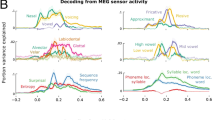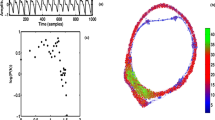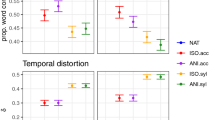Abstract
The mathematical model is offered to describe an algorithm for functioning of a speech rhythm. The duration of a speech signal is divided into the numbered sequence of durations of voice and voiceless segments. All elements of this sequence will be considered as values normalized on the maximum element. We determine this sequence of the elements as a speech rhythm. 1) The model describes a speech rhythm as the recurrent relations between elements of a rhythm. 2) The model permits use of the concept of information entropy. 3) The model explains experimental findings obtained by our research group during comparative investigation of a rhythm in normal speech and stuttering. In particular, the model explains the existence of two classes of stutterers with various rhythms of speech.
Similar content being viewed by others
References
Port, R., Tajima, K. and Cummins, F.: Speech and rhythmic behavior, in: G.J. Savelsburgh, H. Van der Maas and P.C. Van Geert (eds.), The non-linear analysis of developmental processes, Royal Dutch Acad. of Arts and Sci. Amsterdam, 1998, pp. 5–45.
Packman, A., Onslow, M. and van Doorn, A.: Syllabic stress and variability: A model of stuttering, Clinical Linguistics & Phonetics 10 (1996), 235–263.
Onslow, M., Packman, A., Stocker, S., et al.: Control of children stuttering with response-contingent time-out, J. Speech Lang. Hear. Res. 40 (1997), 121–133.
Browman, C.P. and Goldstein, L.M.: Towards an articulatory phonology, in: C. Ewan and J. Anderson (eds.), Phology yearbook 3, Cambridge University Press, Cambridge, 1986, pp. 219–252.
Skljarov, O.P.: The bifurcation model of the speech rhythm and stuttering, in: P. Perrier (ed.), Proc. of the 1 st ESCA Tutorial and Research Workshop on Speech Production Modelling: From Control Strategies to Acoustics & 4 th Speech Production Seminar: Models and Data, Stendhal University, Grenoble, 1996, pp. 89–92.
Skljarov, O.P.: The perception of the own delay speech as a tool for start-upping of the rhythm at the stuttering, in: W. Ainsworth and S. Greenberg (eds.), Proc. of the ESCA Workshop on the Auditory Basis of Speech Perception, Keele University, Keele (UK), 1996, pp. 279–282.
Skljarov, O.P. (Oleg S.): The self-organization nature of speech rhythm and stuttering, J. of Fluency Disorders 22 (1997), 139.
Skljarov, O.P.: The chaotical generator of speech, in: K. Ponting and R. Moore (eds.), Proc. of NATO Advanced Study Institute Computational Models of Speech Pattern Processing, 1, Jersey, (UK), 1997.
Skljarov, O.P.: Role of perception of rhythmically organized speech in consolidation process of long-term memory traces (LTM-traces) and in speech production controlling, in: G. Kokkinakis and N. Fakotakis (eds.), Proc. of the 5 th European Conference on Speech Communication and Technology (Eurospeech' 97), 4, University of Patras, Patras, 1997, pp. 2147–2150.
Skljarov, O.P.: Content-independent duration model on categories of voice and unvoice segments, Proc. of the International Conference on Spoken Language Processing. ICSPL'98, Dec. 1998, Australia, Sydney, pp. Fr1Q11–Q14.
Sklyarov, O.P.: Self-organization nature of the speech rhythm (the voice source model), Biophysics 43, 152–158.
Schuster, H.G.: Deterministic Chaos: An Introduction, Physik-Verlag, Weinheim, 1984.
Sackellares, J.C., Iasemidis, L.D., Zaveri, H.P., et al.: Measurements of chaos to localize seizure onset: Abstract, Epilepsia 30 (1989), 663–664.
Zwiener, U. Hoyer, D., Schmidt, K., et al.: Nonlinear dynamics in pathophysiology - A review. III Int. Congr. Pathophysiol., Lahti. Pathophysiology 5, Suppl. 1 (1988), p. 257.
Nicolis, G. and Prigogine, I.: Exploring complexity: An introduction, W.H. Freeman & Company, New York, 1989.
Elbert, T., Ray, W.J., Kowalik, Z.J., et al.: Chaos and physiology: Deterministic chaos in excitable cell assembles. Physiol. Rev. 74 (1994), 1–47.
Maas van der, H.L.J., Vershure, F.M.J. and Molenaar, P.C.M.: A note on chaotic behavior in simple neural networks, Neural Net. 3, 1990, 119–122.
Greenberg, S.: Understanding speech understanding: Towards a unified theory of speech perception, in: W. Ainsworth and S. Greenberg (eds.), Proc. of the ESCAWorkshop on the Auditory Basis of Speech Perception, Keele University, Keele (UK), 1996, pp. 1–8.
Brown, G. and Cooke, M.: Temporal synchronization in a neyral oscillator model of primitive auditory stream segregation, in: Proc. Workshop on Comput. Auditory Scene Anal. Montreal, 1995, pp. 40–47.
Author information
Authors and Affiliations
Rights and permissions
About this article
Cite this article
Skljarov, O. Nonlinear Neurodynamics in Representation of a Rhythm of Speech. Journal of Biological Physics 25, 223–234 (1999). https://doi.org/10.1023/A:1005156019118
Issue Date:
DOI: https://doi.org/10.1023/A:1005156019118




